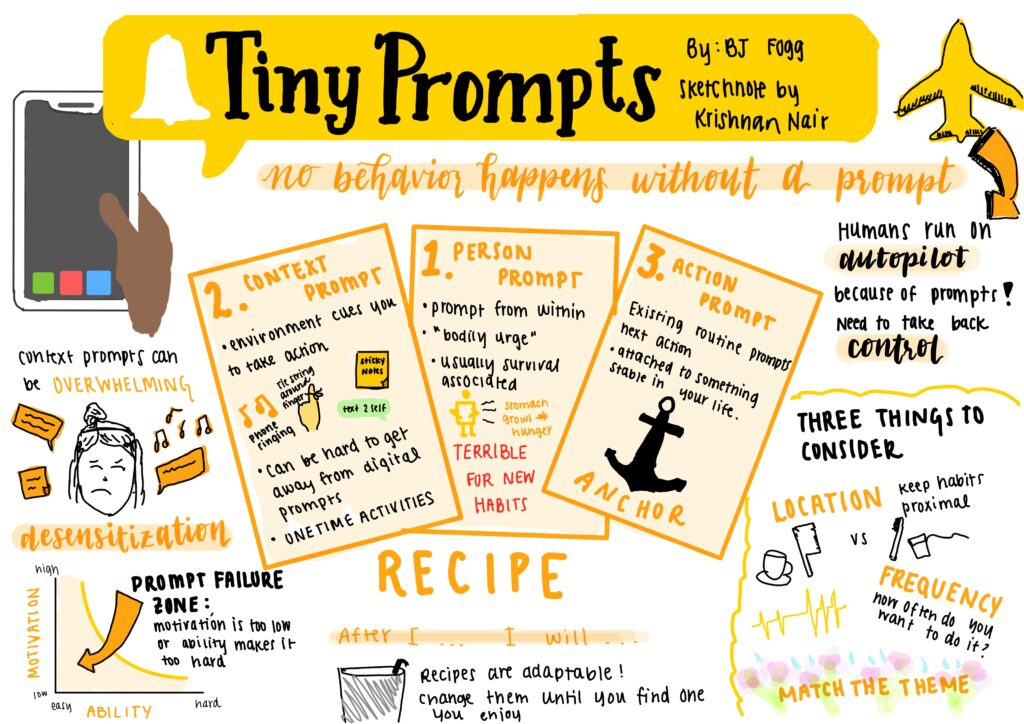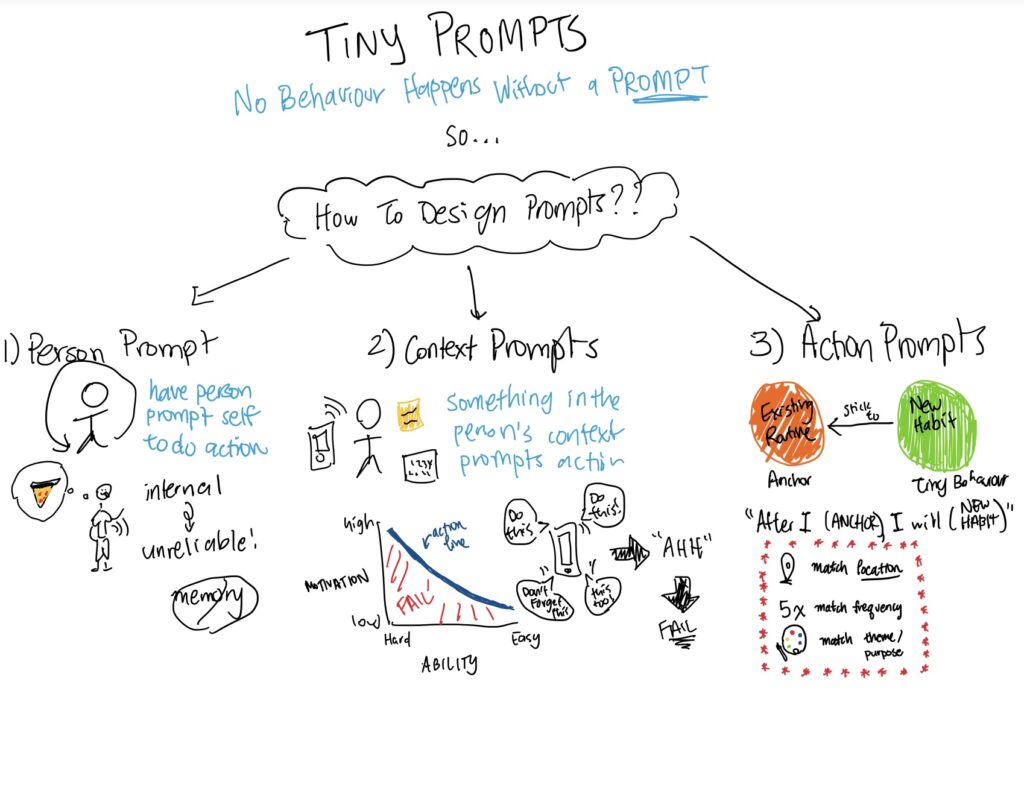Product Overview
Soup & Bread is a mini-franchise with 5 locations along the Oregon Coast, serving high-quality, homemade soups and freshly baked breads or rolls. Having reached local market saturation, we are now expanding into Northern California urban areas, where there is a growing demand for convenient but consistently high-quality, healthy food options. To meet the customer values of the Bay Area, we introduce Soup & Bread Express: a quick, convenient version of our traditional restaurants that allows customers to in-store and mobile order all varieties of breads, soups, and cookies from our traditional menu. Soup & Bread Express meets the unique needs of both our new customer base, tech workers and other working professionals who value digital ordering for quick, healthy meals, and our existing customer base, families who seek high-quality food products with less preparation time.
Scope and Objectives
Scope
Soup & Bread Express introduces an addition to the franchise’s traditional sit-down restaurants to stay at the forefront of the needs of busy working professionals and families in urban areas. This project aims to introduce Soup & Bread Express as a healthy fast-food option while staying true to the brand’s original values. Thus, we allow two options for ordering, in-store, and mobile, and provide a healthy core menu of soups, breads, and cookies as well as seasonal offerings to meet customer needs for convenient and healthy, cozy food. However, we do not provide a sit-down area or wait staff and we do not participate in delivery services, in line with our convenient take-out model.
Objectives
Primary Objectives
- Expansion into San Francisco: Launch 4 Express locations by Year 2.
- Building our mobile and web platform: Build a mobile app and expand our web platform to allow for mobile ordering.
- Menu diversification: Increase menu options by introducing vegan/seasonal/GF offerings.
Secondary Objectives
- Increasing repeat customer visits by 20% after opening our first location by offering tiered rewards to loyalty members.
- Collaborate Locally: Establish partnerships with local businesses and events to create visibility and integrate into the community culture.
User Personas
Target Users
Our target customer segments are affluent, busy working professionals in their 20-30s and families in San Francisco who seek healthy, convenient food options. From our interviews, we identified key pain points of lacking time (“On busy days, I would rather just grab and go”) and not being able to find high-quality and healthy yet affordable food. There is a need for a service that combines all four of these needs: convenient/fast, high-quality, healthy, and affordable food.
User Personas
- Grace (23) is a startup founder in San Francisco. She often skips lunch because she is busy at work and does not want to take out fast food since it’s unhealthy. She is starting to get tired of having to pack food every morning and is looking for convenient, healthy food options near her workplace.
- Joseph (22) is a health-conscious, new-grad software engineer who goes to the gym daily and cares about where his food is sourced. However, he does not yet have enough savings to purchase expensive, healthy food every day.
- Renee (37) is a mom of three who leads a busy life taking care of her kids. Additionally, she is also preparing to go back into the workforce and it is no longer sustainable for her to rely on grocery shopping and cooking meals every week for her family. She is looking for equally cozy and affordable food like the soup and sandwiches she often makes for her kids at home.
User Stories
For the busy professional: “As a busy professional with little time to cook, I want a convenient dinner spot that I can rely on for comforting and healthy meals.”
For the health-conscious: “As a health-conscious person who cares what I put into my body, I want to find nourishing, clean food to eat so I can reach my fitness goals and still be filled and satisfied.”
For the busy parent: “As a mom with a full-time job and 2 kids, I want nutritious and tasty food my kids enjoy and I feel good about feeding them.”
For the tired city-dweller: “As a busy person living in a busy city, I’m tired and I want to treat myself to an easy, comforting meal so I can relax and feel better.”
For the homebody: “As a person who likes to stay in the comfort of my own home, I want to order takeout and enjoy food that reheats well so that I can enjoy my meal in pajamas on my couch.”
For the budget-conscious: “As a person who wants to save money, I want to order food and pick it up myself so I don’t have to tip for dine-in service or spend money on delivery.”
Functional Requirements
| Requirements | Priority |
| Mobile app:
Customers need to be able to download our app on iOS and Android devices in order to place mobile orders. Menu items should be easy to find and orders easy to place. |
Pre-launch primary |
| Customer Registration and Authentication:
Customers need to be able to create an account on the app. We need secure authentication to protect sensitive data such as credit card info. |
Pre-launch secondary |
| Brick & mortar kitchen and storefront:
Kitchen needed to prepare food and pack orders and a storefront to support foot traffic and in-person orders. |
Pre-launch primary |
| Head Chef & Trained Kitchen Crew:
Labor must consistently and efficiently produce high quality food customers expect. |
Pre-launch primary |
| Local supplier contracts:
Restaurant must be continuously supplied with ingredients required to deliver on all menu items. Bread and cookies to be outsourced to local bakeries. |
Pre-launch primary |
| Sustainable Packaging:
Customers should receive their food in elegant, environmentally-friendly containers that match the value of the quality food inside. Packaging also serves as brand marketing. |
Pre-launch secondary |
| Core menu offerings:
4-5 different soups, 3 types of bread, and 3 cookie flavors that will be available year round. Similar to the tried-and-true menu from original Oregon Soup & Bread locations. |
Pre-launch primary |
| Special menu offerings:
Special menu offerings bring in new customers and keep existing customers excited to return. Customers should be able to order a different special seasonal soup each quarter. One vegan soup should be on the menu. Gluten free bread should be an additional bread option. |
post-launch secondary |
| Social Media presence:
Attract new customers to place their first order. Cultivate community and easily alert loyal base about new offerings and deals. |
Pre-launch secondary |
Non-functional Requirements
| Requirement | Description |
| Performance | Online platform handles high traffic during peak hours (lunch/dinner).
Restaurant operations ensure customer orders are prepared and served within 10-15 minutes to meet fast-casual expectations. Optimize in-store workflows (e.g., order taking, preparation, and pickup areas) for high efficiency. |
| Scalability | Physical locations are designed to scale quickly in new urban markets.
Commercial zoning kitchen layouts to accommodate demand associated with the fast-casual experience. Flexible pop-up setups for testing new regions and products. |
| Reliability | Consistent quality control for all dishes across locations.
Backup kitchen equipment (e.g., stoves, refrigeration) to minimize downtime during mechanical failures. Schedule regular maintenance for physical assets (kitchen appliances, seating, and decor). |
| Security | Install secure systems in physical locations to protect customer data during in-store transactions.
Surveillance cameras and alarm systems to safeguard inventory, staff, and customer safety. Reliable storage for perishable items to prevent food spoilage and contamination. |
| Usability (Digital) | Intuitive kiosk interfaces for in-store orders.
Mobile app provides real-time updates on order status and estimated pickup times. |
| Usability (Physical) | Clear signage for self-service and pickup, customers.
Layouts optimized for a pickup-first business model. Accessible facilities, including ADA-compliant entrances. |
| Compatibility | Ensure kitchen and front-end equipment compatibility with local utility standards (e.g., electricity, water).
Consistent customer experience across online, mobile, and in-person channels. |
| Compliance | Strict adherence to food safety standards for kitchen operations and staff training.
Compliance with local building codes for restaurant construction and zoning laws for pop-ups. Sustainability compliance for packaging and waste management, including using biodegradable materials. |
| Analytics & Reporting | Track foot traffic in physical locations using door-opening sensors.
Collect and analyze customer feedback in-store through QR codes or kiosks. Collect and analyze customer feedback online through emails. inventory tracking systems that connect to digital orders for real-time menu updates. |
| Physical Experience | Offer a clean, modern, and welcoming dining environment that aligns with the brand identity.
Open kitchen layouts emphasize transparency and connect customers with the preparation process. |
| Customer Service (Digital) | Online support for order assistance and FAQs.
App notification for order readiness and promotions. |
| Customer Service (Physical) | In-store staff are trained in customer interaction, including dietary needs (e.g., vegan, allergy-friendly).
Provide accessible self-service pickup stations with clearly labeled orders. Offer easy-to-use customer feedback forms or surveys at each location. |
| Industry-Specific | Display nutritional information and allergen warnings both digitally and in-store.
Local partnerships with suppliers for fresh, cost-efficient, and sustainable ingredients. |
Wireframes/Storyboards/Mockups/Prototypes
Low-Fidelity Mobile Pick-up Order Flow
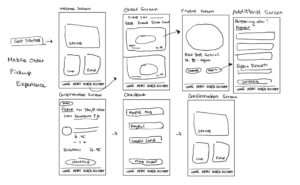
Mobile Ordering Experience

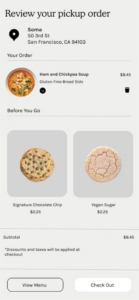
In-Store Ordering Kiosk
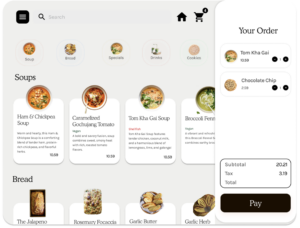
Constraints and Assumptions
Constraints and Limitations
New location (SF SOMA)
- Ingredient sourcing: Our commitment to locally-sourced ingredients for core-menu items and seasonal offerings is limited by the fresh ingredients available in the 50-100 mile radius. Furthermore, unexpected weather patterns and seasonal changes or supply chain fluctuations may make some offerings unavailable to procure.
- Quality control: As a restaurant, we always run the risk of receiving ingredients (and thus serving food) that may be not up to standard, resulting in customer dissatisfaction, or at worst, food poisoning incurred from consuming our products. If we plan on partnering with food delivery services later down the road, we run the risk of deteriorated food quality in transportation.
- Service quality: On the customer service quality control side, during peak hours, our staff may not be able to prepare orders fast enough to meet customer expectations.
- Mitigation Strategy: Highlight seasonal and local menu items to customers so that menu variation is expected and a part of our brand. To maintain quality control of ingredients, our supplier relationships must be upkept so that expectations for order frequency and quality can be fulfilled, and we must also have at least 2 backup suppliers. We will vigilantly train our kitchen staff to be conscientious about food safety and freshness standards. Furthermore, we will efficiently shift our workers so that there is enough support during peak meal-time hours and prioritizes fast turnaround time.
New market (From sit-down to fast casual)
- Change of values: Without a traditional sit-down experience, in which we created a brand, culture, and community that we excelled at, it’s possible that the strong community aspect that drives our customer loyalty is lost. It is also possible that our strengths in sit-down restaurants with high quality service and local community involvement are not replicable in this new market.
- Mitigation Strategy:: Training for our servers will emphasize compassionate, personalized service. We will have an open-kitchen model where customers can see the food being prepared, and origin-stories of ingredients will be highlighted in the restaurant. Other ideas to introduce community include pop-ups at SF festivals and farmers markets, such as Outside Lands FoodieLands and being involved in local events.
Key assumptions
#1 – Food Quality Over Restaurant Experience
- Assumption:
- Customers prioritize food quality over ambiance in their dining experience.
- Supporting Evidence:
- Assumptions testing with Bay Area young professionals revealed that food quality is the hallmark of satisfaction and a key factor for return visits.
- Implications:
- Financial resources will be focused on ingredient quality and preparation, rather than extensive investment in ambiance.
#2 – Willingness to Pay ($15+ for Soup and Bread Combo)
- Assumption:
- Target customers will find a price point of $15 reasonable for a soup and bread combo.
- Supporting Evidence:
- A survey of 20 individuals found that 50% were willing to pay this amount.
- Higher price points were justified for premium items (e.g., crab bisque) compared to more standard offerings (e.g., chicken noodle soup).
- Adaptations:
- Implement a tiered pricing model offering options at different price points to cater to diverse customer budgets.
- Refine pricing strategies based on customer feedback during the first year of operations.
#3 – Attraction to Seasonal and Limited-Edition Offerings
- Assumption:
- Seasonal and limited-edition offerings will attract new customers, continuing the success of the core product strategy from past ventures.
- Supporting Evidence:
- Boomerang testing with competitor brands (e.g., Panera, Sweetgreen) suggested seasonal items are not a decisive factor for many customers. However, the sample size was limited.
- Adaptations:
- Launch initial seasonal offerings to capture customer interest, monitor performance, and adjust
Ethical implications:
- Employee treatment
- Potential ethical concerns include mistreatment of our employees. We see employee culture to be an extension of our brand and highly central to our success. As such, in balancing our goals to be profitable, we will value paying our employees a competitive wage, celebrate their work and personal accomplishments, and be adaptable to their needs. We value inclusion and diversity of different backgrounds and skills, which we will factor when hiring.
- Customer treatment
- Potential ethical concerns include lack of transparency with our customers and making decisions for profitability over their best interest (health, accessibility, etc). As customer loyalty has been a strength and value of ours in the past, we aim to build not only a great relationship with our customers, but also foster a community between customers in their shared interest for healthy, sustainable food and living. We plan on being transparent in food ingredients and sourcing, as well as getting involved in the local community in supporting events and partnering with other local businesses.
- Environmental Impact
- As a restaurant, it is expected that in tossing leftover food, using single use packaging, transporting goods, that we will leave a carbon footprint. To minimize the size, we are committed to sourcing our ingredients locally and using sustainable compostable packaging whenever possible.
- Data privacy
- In our mobile app that enables customers to place orders, we will have access to customer payment data among other sensitive information. To prevent misuse of this entrusted data, we will safeguard it with robust security practices and not distribute this data.
Milestones and Timeline
| Milestone & Objectives | M1-M3 | M4-M6 | M7-M9 | M10-M12 | M13-M24 |
| Location Scouting & Mobile Ordering Development:
Find a prime location in SOMA and develop a digital platform to streamline ordering. |
Scout locations in SoMa and start the initial ordering app development & design for ordering | Finalize lease, app ready for testing with users | Launch mobile ordering alongside express location | Optimize app for location scalability | |
| MVP Launch (classic menu items; mobile order option): Launch the express location with a limited menu and basic ordering options to test the core concept. | Prepare kitchen for soft launch and finalize recipes | Launch MVP with classic items and no menu rotation | Refine menu based on feedback | Include app-supported customization | |
| Customer Feedback Collection: Gather customer input to refine offerings, service workflows, and digital tools. | Conduct pre-launch surveys to understand customer preferences | Collect feedback from in-store customers and app users | Analyze feedback from soft launch for operational improvement | Identify top-performing items and refine menu strategy | Adapt feedback to expand offerings in new locations |
| Second Release: Expanded Menu (+vegan/GF/seasonal items): Expand the menu to include vegan, gluten-free, and seasonal offerings for a broader appeal | Develop and test seasonal/vegan/GF recipes | Introduce expanded menu alongside MVP updates | Focus on testing and integrating customization options for dietary preferences | Maintain seasonal rotations and personal customization | |
| Expansion Planning: Plan for scaling to additional locations based on data and market research | Identify opportunities for future locations based on initial data | Conduct feasibility studies for other areas in San Francisco | Finalize plans for new express locations | Standardize processes for multi-location operations. Open 2 additional express locations by M24 | |
| Curate Initial Recipes: Collaborate with chefs to curate a menu with high-quality products | Finalize and test classic recipes | Refine recipes based on initial customer input | Develop expanded seasonal menu | ||
| Operations & Logistics: Build an efficient supply chain and kitchen workflow to ensure operations efficiency | Partner with local suppliers and build inventory | Finalize kitchen and supply chain logistics | Evaluate and refine workflows post-launch | Expand logistics and operations to scale at multiple locations | |
| Train Staff: Train kitchen & front of house staff working at the express location | Develop training manuals and onboarding materials | Train staff for soft launch, focusing on workflow efficiency | Scale training programs for new hires at the additional locations | ||
| Marketing: Market the brand to build awareness, engagement, and loyalty among customers | Run pre-launch campaigns on social media | Promote SoMa location on existing media channels and pop-up events | Use loyalty programs and targeted ads for new areas |
Resource Requirements
1. Team Members
- Marketing Strategist / Social Media Manager
- Responsible for branding and promotional campaigns tailored to the tech-forward SF market.
- Focuses on raising awareness of the express concept and seasonal offerings; creates engaging content for platforms like Instagram, TikTok, and Twitter.
- Mobile App Engineers (2 Front-End, 1 Back-End)
- Develop and maintain a user-friendly app for ordering, loyalty programs, and push notifications.
- Integrate payment systems, order tracking, and pick-up scheduling.
- Key deliverables: MVP app launch, iterations based on pilot feedback.
- UI/UX Designer
- Designs a seamless user experience for ordering on the pilot mobile app
- Works closely with engineers to ensure intuitive navigation and brand consistency.
- Head Chef
- Ownership of key and seasonal offerings and recipe adaptation for grab-and-go portions while maintaining quality
- Kitchen Support Staff (3)
- Prep cooks and line cooks for quick, high-quality food assembly.
- Focused on batch preparation and efficient service.
- Customer Experience Specialist
- On-site staff to handle customer inquiries, app-related issues, and overall satisfaction.
- Acts as the bridge between mobile orders and walk-ins.
- Supply Chain Specialist:
- To secure local suppliers for SF operations.
2. Tools
Operational Tools:
- Kitchen Equipment
- Compact soup warmers, bread warmers, and prep stations
- Vacuum sealers or portioning tools for efficient grab-and-go packaging.
- Point-of-Sale (POS) System
- A cloud-based POS with mobile order integration (e.g., Square, Toast).
- Features: Inventory management, payment processing, and sales analytics.
- Packaging Materials
- Branded eco-friendly grab-and-go containers and utensils to appeal to SF’s sustainability-conscious market.
- Digital Order Displays:
-
- Screens for pick-up queue management.
- Integrates with the app for a cohesive customer experience.
3. Key Technologies
Mobile App Development:
- Frontend Frameworks:
- React Native for cross-platform compatibility (iOS and Android).
- Backend Infrastructure:
- Firebase or Supabase for real-time database management and user authentication.
- Stripe or Square APIs for secure, seamless payment integration.
- Analytics Tools (In the future):
- Google Analytics for app usage tracking.
Financial Breakdown of the Ask:
Personnel Costs (Annual):
- Core Team Salaries: $730,000
- Engineers ($100k/engineer), Designer ($80k), Marketing roles ($80k), Head Chef ($100k), Kitchen staff ($120k combined), Customer Specialist ($50k), Supplier Specialist: $50,000
Technology and Equipment:
- App Development: $150,000
- App hosting, and maintenance.
- Kitchen Setup: $75,000
- Compact equipment, eco-friendly materials, and initial inventory.
- Digital Systems: $25,000
- POS systems, digital displays, and analytics subscriptions.
Space Rent
- Annual Rent: 2,000 sq ft × $51/sq ft = $102,000
Marketing and Launch Costs:
- Initial Campaigns: $50,000
- Social media ads, app launch promotion, and local partnerships.
Total Ask: $1,182,000
Testing and Quality Assurance
Flavor Consistency: Perform batch tests to ensure consistent flavor profiles across all soups and breads, regardless of production size.
- Texture and Freshness: Assess the texture and freshness of soups (e.g., chunkiness, creaminess) and breads (e.g., crustiness, softness) during storage and reheating.
- Mitigation: Utilize spill-proof containers for soups and moisture-lock packaging for breads to maintain freshness.
- Nutritional Accuracy: Verify that soups and breads meet nutritional claims (e.g., calorie count, allergen-free options).
- Scalability: Test production scalability by preparing larger batches while maintaining quality.
- Reheating Guidelines: Evaluate the effectiveness and clarity of reheating instructions for soups and breads.
Metrics and Success Criteria
The signals gathered from the first location will guide our decision on whether to expand
Acquisition and Onboarding:
- New Customer Growth Rate: The rate at which new customers try our soups and breads during the initial phase.
- Conversion Rate: The percentage of app/website visitors who place an order for soups or breads.
- Onboarding Completion Rate: The percentage of users who successfully complete the mobile ordering process for Soup and Bread.
Engagement and Retention:
- Repeat Purchase Rate: The percentage of customers who reorder soups or breads within a given time frame.
- Active Engagement Rate: How frequently customers interact with the app or in-store kiosks to order soups and breads.
- Feedback Interaction Rate: The frequency of customer feedback submissions regarding soups and breads.
Customer Satisfaction and Feedback:
- Customer Satisfaction (CSAT) Score: Customer feedback on the quality and appeal of the soups and breads.
- Net Promoter Score (NPS): How likely are customers to recommend our soups and breads to others?
- Customer Reviews: The quality and sentiment of customer reviews for soups and breads.
Success Criteria for Soups and Breads
With targeted promotions and a focus on seasonal offerings, we anticipate that 25% of first-time visitors to our MVP location will explore the soups and breads menu. Of these, we expect 8-10% to make an initial purchase. For retention, our goal is to achieve a 12-18% repeat purchase rate within the first year, aligning with industry benchmarks for
Objectives and Key Results (OKRs)
| Objectives | Increase engagement & sales | Maintain high customer satisfaction for offerings. |
| Result #1 | Achieve a 15% increase in purchases within six months of launch. | Achieve a 90% positive feedback rate on during the first year. |
| Result #2 | Drive a $500K revenue increase sales in the first year of operations. | Keep complaints (e.g., food quality) under 2% of total sales within the first year. |
Go-To-Market Strategy
Target Audience and Segmentation
We are focused on serving urban professionals in SF, Soma Area. These individuals lead fast-paced lives and appreciate options that align with their busy schedules, including cozy, healthy, high-quality meals they can grab on the go. Our messaging will highlight convenience, premium ingredients, and seasonal menu offerings, catering to their values of quality and efficiency.
- Demographic Expansion: Target residents and workers in adjacent areas like SOMA and the Financial District to maximize reach.
- Behavioral Segmentation: Highlight different benefits for sub-segments, such as lunch convenience for workers and weekend indulgence for foodies.
Value Proposition and Messaging
Our value proposition is to offer “cozy food on the go,” blending the warmth of home-cooked meals with the efficiency of fast-casual dining. We emphasize quality ingredients, a rotation of seasonal soups and breads, and a seamless mobile ordering experience. Through consistent branding and messaging, we will communicate this unique appeal across all customer touchpoints.
Marketing and Promotion Plan
Pre-Launch Marketing
- Social Media Campaigns: Use Instagram and TikTok to build anticipation with behind-the-scenes content, seasonal menu highlights, and local ingredient sourcing.
- Pop-Up Events: Host free tasting pop-ups at coworking spaces, farmers’ markets, and parks to drive awareness and collect pre-launch feedback.
- Partnerships: Collaborate with local influencers in SF to promote the launch.
Launch Marketing
- Referral Program: Early users receive discounts for referring friends to the mobile app.
- Local Sponsorships: Partner with community events and urban wellness programs (e.g., yoga studios, tech meetups).
- Promotional Offers: Offer “Opening” discounts during the first week to drive foot traffic and app downloads.
Distribution Strategy
Our distribution strategy revolves around physical retail locations in strategic urban areas, where customers can quickly pick up meals. Mobile ordering will complement this setup, allowing busy professionals to pre-order and minimize wait times. This dual approach ensures we cater to both digital-first users and those who prefer in-person interactions.
Sales Strategy
Our sales strategy incorporates both self-service and direct sales models. Self-service will be facilitated through online orders and in-store kiosks, appealing to urban professionals who value quick and efficient processes. At the same time, a direct sales team will provide a personalized touch for customers who prefer placing orders in person. This blend of self-service and direct interaction ensures flexibility and accommodates diverse customer preferences.
Launch Plan
Official Launch Announcement
The launch will feature:
- Social Media Campaigns To Generate Excitement
- Free samples and discounts for the first 100 customers at the SoMa location
- Branded pop-ups at local community events to boost awareness.
Post-Launch Phase
- Performance Analysis: Monitor KPIs such as purchase volume, customer satisfaction, revenue growth
- Customer Feedback Integration: Regularly collect customer feedback through app and in-person experiences to update the menu and address pain points
- Product Improvements: Test new menu options and customization options. Scale to new locations in San Francisco based on feedback and projected demand
Customer Support and Service
Customer support will be prioritized through a dedicated front-of-house representative to handle issues related to the app and ordering experience. For mobile orders, we will provide a quick onboarding introduction upon entering the app. Feedback collection will be integrated into the customer journey, with ratings and suggestions solicited after every transaction—via the app for online orders and digital receipts for in-store transactions. Social media engagement will also serve as a channel for customer interaction and feedback.
Minimum Viable Product (MVP) / First Location
Our first restaurant location will act as the foundation for testing and refining our concept (MVP location). Customer feedback will play a pivotal role in shaping our evolution. We will actively monitor preferences, analyzing what resonates with diners and identifying areas for improvement. By staying attuned to customer needs and adapting our offerings accordingly, we aim to fine-tune our menu, ordering process, and overall experience to meet and exceed expectations, ensuring our concept grows in alignment with customer desires based on the success metrics and criteria we have defined in the previous section. In addition, our first location will also help us test our operational efficiency, measuring workflows for fast service and high-order accuracy. It will also help us define our scalability, looking at how we can replicate the process in other locations.
References
- https://www.qualtrics.com/experience-management/customer/what-is-csat/#:~:text=CSAT%2C%20or%20customer%20satisfaction%20score,0%25%20would%20be%20terrible).
- https://www.qualtrics.com/experience-management/customer/net-promoter-score/
- https://pos.toasttab.com/blog/on-the-line/restaurant-turnover-rate?srsltid=AfmBOoqyQA9tLoTp9q4SVATnxCfevQt64oCtLpMbrIxPIKuqNt1zCs0Z
- https://notch.financial/blog/restaurant-turnover-rate/
- https://www.loopnet.com/search/retail-space/soma-san-francisco-ca/for-lease/
- https://highercommonsense.com/cs247b/soup-bread-one-pager/
- https://pitch.com/v/soup-bread-jec5zj
- https://www.nrn.com/finance/fast-casual-emerges-sweet-spot-restaurant-industry-growth
- https://straitsresearch.com/report/fast-casual-restaurant-market
- https://www.quora.com/My-fees-for-delivery-are-too-high-with-DoorDash-are-there-other-ways-I-can-offer-delivery-without-paying-high-commission-on-every-order
- https://www.cnbc.com/2024/07/27/food-delivery-fees-are-rising.html
- https://www.jmir.org/2021/10/e28689/

